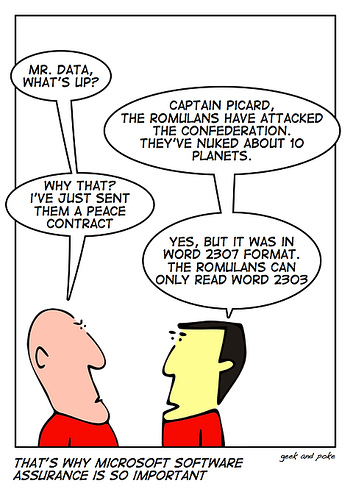 The Romulans attack the Federation for they can’t read the Peace Treaty sent to them in Word 2307 format… they only have Word 2303. A hilarious cartoon by Geek and Poke. Joke? Perhaps … or not.
The Romulans attack the Federation for they can’t read the Peace Treaty sent to them in Word 2307 format… they only have Word 2303. A hilarious cartoon by Geek and Poke. Joke? Perhaps … or not.
Yesterday I attended a (so-called) Enterprise 3.0 event hosted by the MIT Club of Northern California. So-called, as nobody really used the term, other than the moderator, Sramana Mitra. The panelists politely put the title on their slides, and then distanced themselves from the concept, Google’s Jonathan Rochelle being most outspoken: “we did not even get to Enterprise 2.0, why 3.0 now?” (Update: read JR’s follow-up post).
That said, it was an interesting event, clearly focused on Software as a Service (SaaS). 3 of the 4 presenters came with PowerPoint decks – kudos to Microsoft’s Cliff Reeves who only had 1 slide. In the spirit of eating one’s own dogfood JR’s “presentation” was a public Google Spreadsheet.
Next came Captain Picard Sramana: her slides suffered the same faith the Federation’s Peace Treaty did: they were created in a different version, and could not be opened on the presenters’s laptop. Host Nicolas Saint-Arnaud made a heroic effort trying to download a converter, but failed, so Sramana could not show her presentation. This happened in a room discussing SaaS where at least two (well, one and a half) online presentation tools were represented: Google’s future presentation app by Jonathan, and the existing Zoho Show by Sridhar. With a Web 2.0 tool, there s no dependency on having the correct software version on your machine, there are no updates, patches (in fact there are, managed behind-the-scenes by the service provider) – your slides (data) are instantly available anywhere, anytime.
I somewhat wonder if this was an intentional ploy on Sramana’s behalf: after all we can talk all we want about the benefits of working on the Web, nothing delivers a punchline as forcefully as a publicly failed download/patch… or the Romulan nukes, for that matter. (Will they still use nukes in the 24th Century?)
(Side-note to anyone delivering presentations: don’t ever try to download and apply an upgrade publicly, on a projection screen. Murphy’s Law will apply)
Update: See Sramana’s Nuggets from the event, including the slides. She says it was not a ploy… (but I may just have given her an idea 😉 )


Recent Comments